Transcriptional Profiles of Mitochondrial Dynamics Markers Are Disturbed in Adrenal Glands of Stressed Adult Male Rats
Abstract
1. Introduction
2. Materials and Methods
2.1. Statement of Institutional Review Board
2.2. A Statement That the Authors Complied with ARRIVE Guidelines and Institutional Animal Care and Use Committee Guidelines
2.3. Animals and Experimental Model of Stress
2.4. Isolation of Adrenal Glands
2.5. Isolation of RNA and cDNA Synthesis
2.6. Relative Quantification of Gene Expression
2.7. Relative Quantification of Protein Expression
2.8. Statistical Analysis
3. Results
3.1. The Transcriptional Profiles of Mitochondrial Biogenesis Markers Were Changed in the Adrenal Gland of Stressed Rats
3.2. Repeated Psychophysical Stress Increased the Transcriptional Profile of Mitochondrial Fusion and Architecture Markers in the Adrenal Gland
3.3. The Transcriptional Profiles of Mitochondrial Fission Markers Were Increased in the Adrenal Gland after Ten Repeated Stress Incidents
3.4. Ten Repeated Psychophysical Stress Incidents Increased the Transcriptional Profile of Mitochondrial Autophagy Markers in the Adrenal Gland
3.5. The Transcription of Mitochondrial Functionality Markers Was Changed in the Adrenal Gland of Stressed Rats
3.6. The Transcription of Adrenergic Receptors, Adrenergic Receptor Kinases, and Glucocorticoid Receptor Was Changed in the Adrenal Gland of Stressed Rats
4. Discussion
5. Conclusions
Supplementary Materials
Author Contributions
Funding
Institutional Review Board Statement
Informed Consent Statement
Data Availability Statement
Acknowledgments
Conflicts of Interest
References
- Dominy, J.E.; Puigserver, P. Mitochondrial Biogenesis through Activation of Nuclear Signaling Proteins. Cold Spring Harb. Perspect. Biol. 2013, 5, a015008. [Google Scholar] [CrossRef] [PubMed]
- Markaki, M.; Tavernarakis, N. Mitochondrial Turnover and Homeostasis in Ageing and Neurodegeneration. FEBS Lett. 2020, 594, 2370–2379. [Google Scholar] [CrossRef] [PubMed]
- Scarpulla, R.C. Transcriptional Paradigms in Mammalian Mitochondrial Biogenesis and Function. Physiol. Rev. 2008, 88, 611–638. [Google Scholar] [CrossRef] [PubMed]
- Scarpulla, R.C.; Vega, R.B.; Kelly, D.P. Transcriptional Integration of Mitochondrial Biogenesis. Trends Endocrinol. Metab. 2012, 23, 459–466. [Google Scholar] [CrossRef]
- Chrousos, G.P. Stress and Disorders of the Stress System. Nat. Rev. Endocrinol. 2009, 5, 374–381. [Google Scholar] [CrossRef]
- Manoli, I.; Alesci, S.; Blackman, M.R.; Su, Y.A.; Rennert, O.M.; Chrousos, G.P. Mitochondria as Key Components of the Stress Response. Trends Endocrinol. Metab. 2007, 18, 190–198. [Google Scholar] [CrossRef]
- Selye, H. Stress and Disease. Science 1955, 122, 625–631. [Google Scholar] [CrossRef]
- Finkel, T. A Clean Energy Programme. Nature 2006, 444, 151–152. [Google Scholar] [CrossRef]
- Pyakurel, A.; Savoia, C.; Hess, D.; Scorrano, L. Extracellular Regulated Kinase Phosphorylates Mitofusin 1 to Control Mitochondrial Morphology and Apoptosis. Mol. Cell 2015, 58, 244–254. [Google Scholar] [CrossRef]
- Rodgers, J.T.; Lerin, C.; Haas, W.; Gygi, S.P.; Spiegelman, B.M.; Puigserver, P. Nutrient Control of Glucose Homeostasis through a Complex of PGC-1alpha and SIRT1. Nature 2005, 434, 113–118. [Google Scholar] [CrossRef]
- García-Bueno, B.; Madrigal, J.L.M.; Pérez-Nievas, B.G.; Leza, J.C. Stress Mediators Regulate Brain Prostaglandin Synthesis and Peroxisome Proliferator-Activated Receptor-Gamma Activation after Stress in Rats. Endocrinology 2008, 149, 1969–1978. [Google Scholar] [CrossRef]
- Weber, K.; Brück, P.; Mikes, Z.; Küpper, J.-H.; Klingenspor, M.; Wiesner, R.J. Glucocorticoid Hormone Stimulates Mitochondrial Biogenesis Specifically in Skeletal Muscle. Endocrinology 2002, 143, 177–184. [Google Scholar] [CrossRef]
- Krauss, S.; Zhang, C.-Y.; Lowell, B.B. The Mitochondrial Uncoupling-Protein Homologues. Nat. Rev. Mol. Cell Biol. 2005, 6, 248–261. [Google Scholar] [CrossRef]
- Selye, H. A Syndrome Produced by Diverse Nocuous Agents. Nature 1936, 138, 32. [Google Scholar] [CrossRef]
- Pitman, R.K.; Rasmusson, A.M.; Koenen, K.C.; Shin, L.M.; Orr, S.P.; Gilbertson, M.W.; Milad, M.R.; Liberzon, I. Biological Studies of Post-Traumatic Stress Disorder. Nat. Rev. Neurosci. 2012, 13, 769–787. [Google Scholar] [CrossRef]
- Sapolsky, R.M. The Influence of Social Hierarchy on Primate Health. Science 2005, 308, 648–652. [Google Scholar] [CrossRef]
- Picard, M.; McManus, M.J.; Gray, J.D.; Nasca, C.; Moffat, C.; Kopinski, P.K.; Seifert, E.L.; McEwen, B.S.; Wallace, D.C. Mitochondrial Functions Modulate Neuroendocrine, Metabolic, Inflammatory, and Transcriptional Responses to Acute Psychological Stress. Proc. Natl. Acad. Sci. USA 2015, 112, E6614–E6623. [Google Scholar] [CrossRef]
- Gak, I.A.; Radovic, S.M.; Dukic, A.R.; Janjic, M.M.; Stojkov-Mimic, N.J.; Kostic, T.S.; Andric, S.A. Stress Triggers Mitochondrial Biogenesis to Preserve Steroidogenesis in Leydig Cells. Biochim. Biophys. Acta BBA Mol. Cell Res. 2015, 1853, 2217–2227. [Google Scholar] [CrossRef]
- Starovlah, I.M.; Sava, R.M.; Marinovic, M.A.; Kostic, T.S.; Andric, S.A. Psychophysical Stress Disturbs Expression of Mitochondrial Biogenesis Markers in Hypothalamus and Adenohypophysis. Biol. Serbica 2017, 39, 43–51. [Google Scholar]
- Starovlah, I.M.; Radovic Pletikosic, S.M.; Kostic, T.S.; Andric, S.A. Mitochondrial Dynamics Markers and Related Signaling Molecules Are Important Regulators of Spermatozoa Number and Functionality. Int. J. Mol. Sci. 2021, 22, 5693. [Google Scholar] [CrossRef]
- Kvetňanský, R.; Mikulaj, L. Adrenal and Urinary Catecholamines in Rats During Adaptation to Repeated Immobilization Stress. Endocrinology 1970, 87, 738–743. [Google Scholar] [CrossRef] [PubMed]
- Starovlah, I.M.; Radovic Pletikosic, S.M.; Tomanic, T.M.; Medar, M.L.; Kostic, T.S.; Andric, S.A. Spermatozoa Develop Molecular Machinery to Recover From Acute Stress. Front. Endocrinol. 2022, 13, 896193. [Google Scholar] [CrossRef] [PubMed]
- Whitley, B.N.; Engelhart, E.A.; Hoppins, S. Mitochondrial Dynamics and Their Potential as a Therapeutic Target. Mitochondrion 2019, 49, 269–283. [Google Scholar] [CrossRef] [PubMed]
- Wang, T.; Shah, Y.M.; Matsubara, T.; Zhen, Y.; Tanabe, T.; Nagano, T.; Fotso, S.; Krausz, K.W.; Zabriskie, T.M.; Idle, J.R.; et al. Control of Steroid 21-Oic Acid Synthesis by Peroxisome Proliferator-Activated Receptor Alpha and Role of the Hypothalamic-Pituitary-Adrenal Axis. J. Biol. Chem. 2010, 285, 7670–7685. [Google Scholar] [CrossRef] [PubMed]
- Doroshenko, E.R.; Drohomyrecky, P.C.; Gower, A.; Whetstone, H.; Cahill, L.S.; Ganguly, M.; Spring, S.; Yi, T.J.; Sled, J.G.; Dunn, S.E. Peroxisome Proliferator-Activated Receptor-δ Deficiency in Microglia Results in Exacerbated Axonal Injury and Tissue Loss in Experimental Autoimmune Encephalomyelitis. Front. Immunol. 2021, 12, 570425. [Google Scholar] [CrossRef] [PubMed]
- Helfenberger, K.E.; Castillo, A.F.; Mele, P.G.; Fiore, A.; Herrera, L.; Finocchietto, P.; Podestá, E.J.; Poderoso, C. Angiotensin II Stimulation Promotes Mitochondrial Fusion as a Novel Mechanism Involved in Protein Kinase Compartmentalization and Cholesterol Transport in Human Adrenocortical Cells. J. Steroid Biochem. Mol. Biol. 2019, 192, 105413. [Google Scholar] [CrossRef]
- Fujita, H.; Habuta, M.; Hattori, T.; Kubota, S.; Kumon, H.; Ohuchi, H. UCP1 Expression in the Mouse Adrenal Gland Is Not Upregulated by Thermogenic Conditions. Biochem. Biophys. Res. Commun. 2021, 566, 184–189. [Google Scholar] [CrossRef]


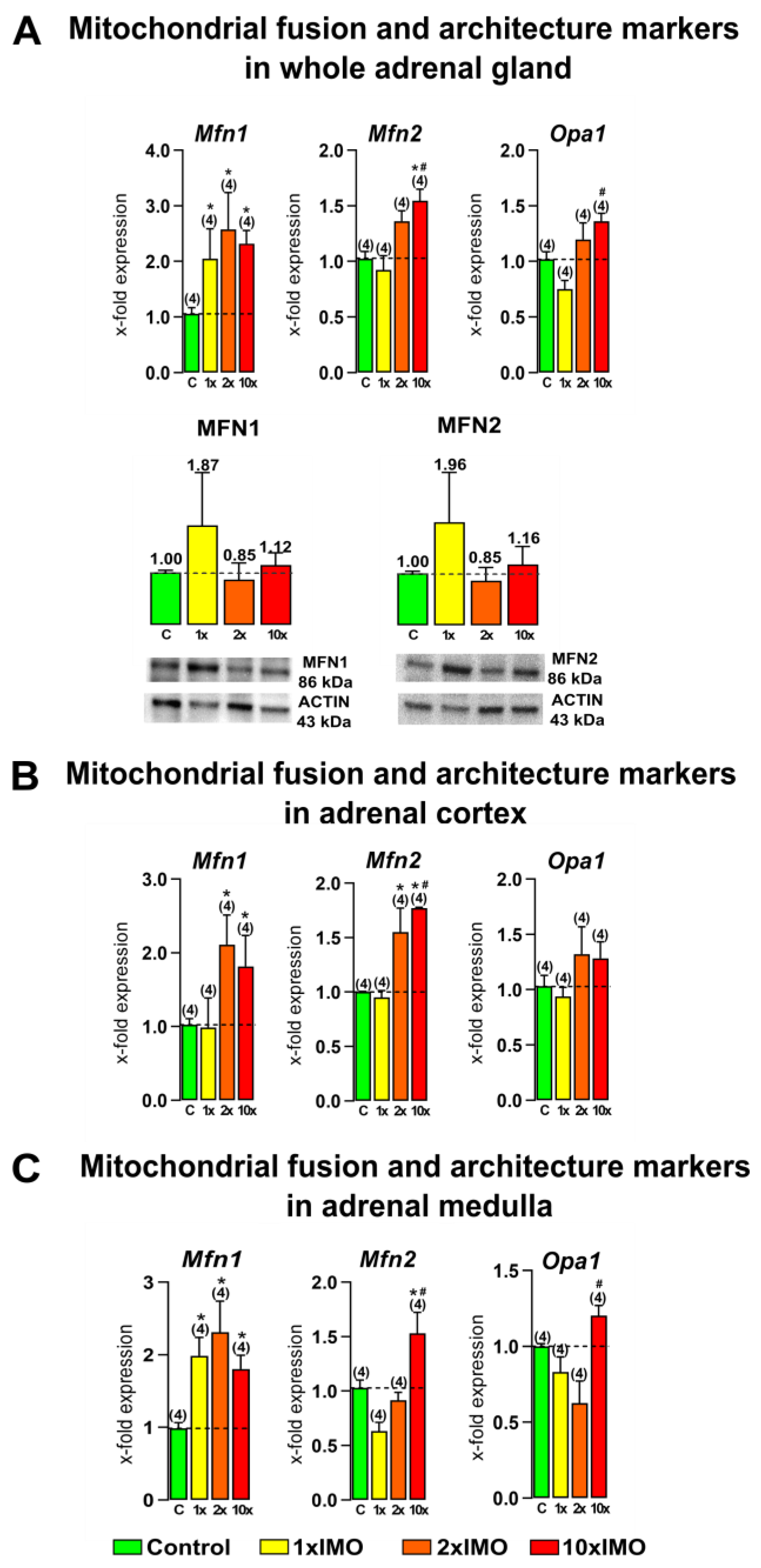
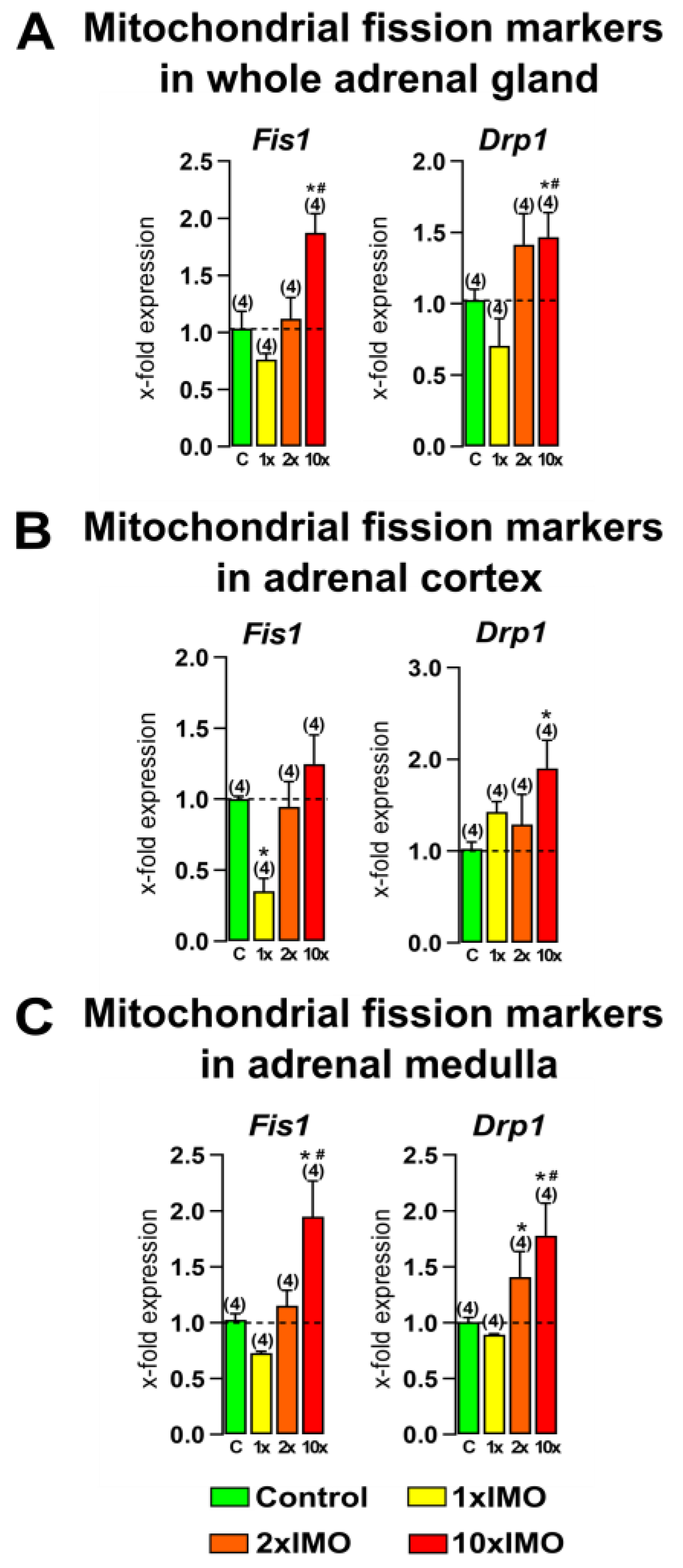
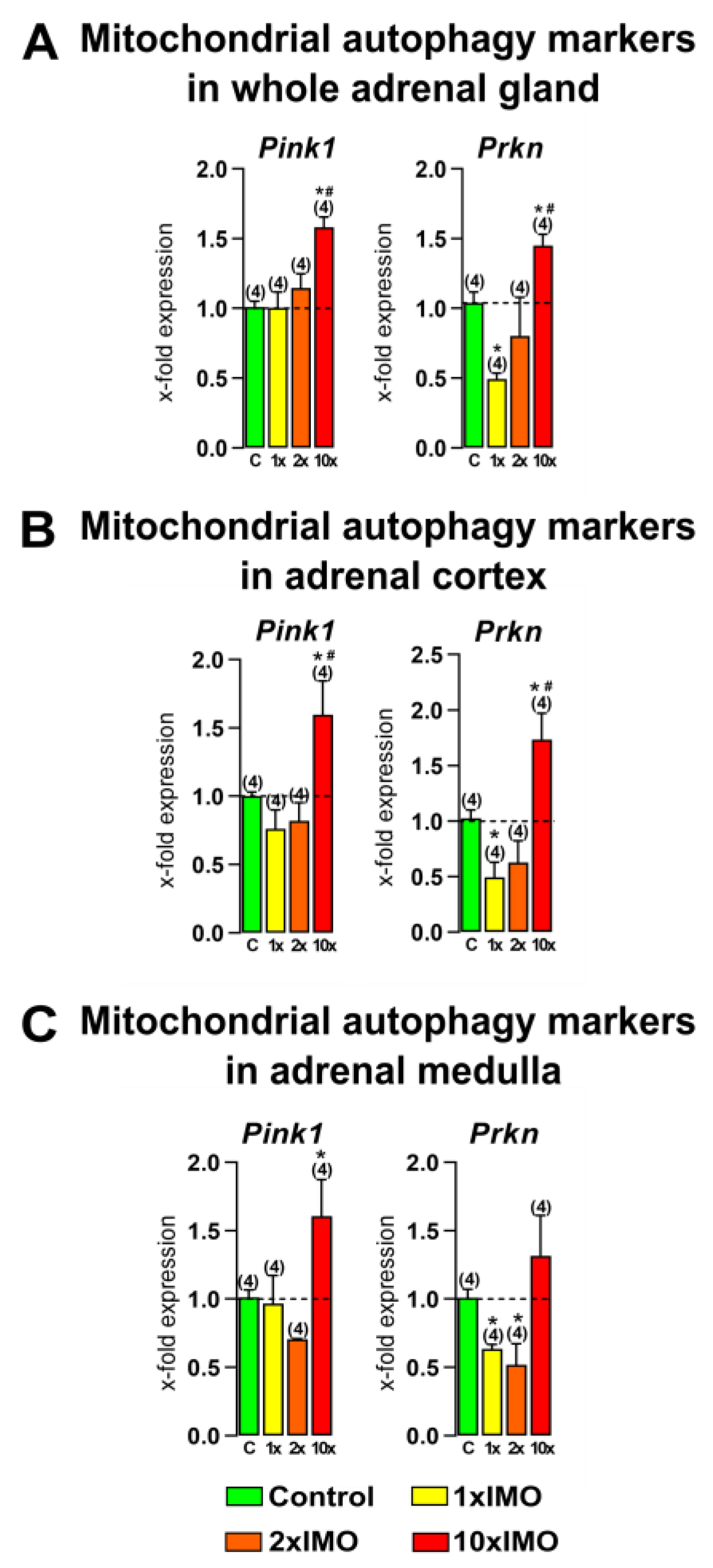
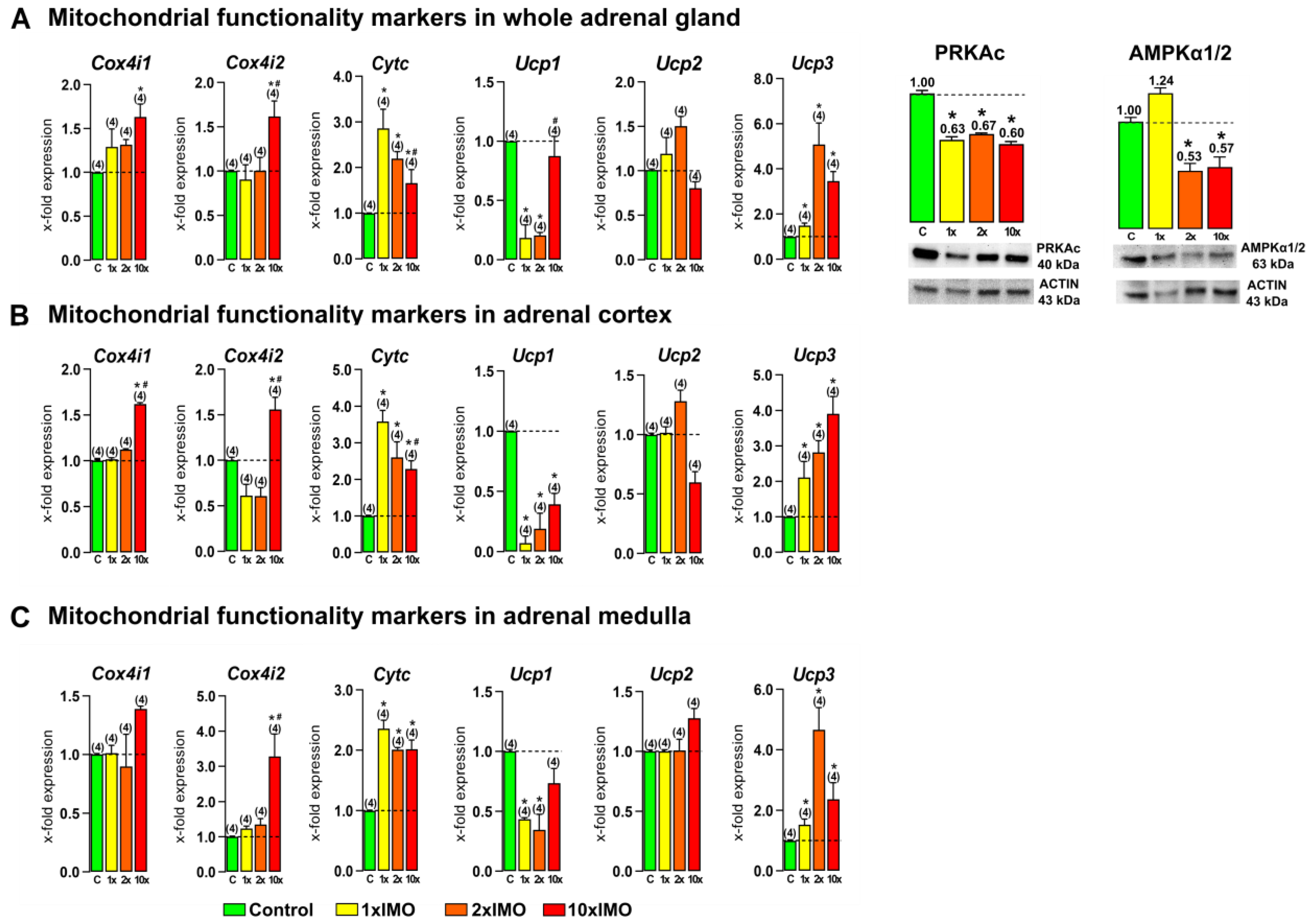

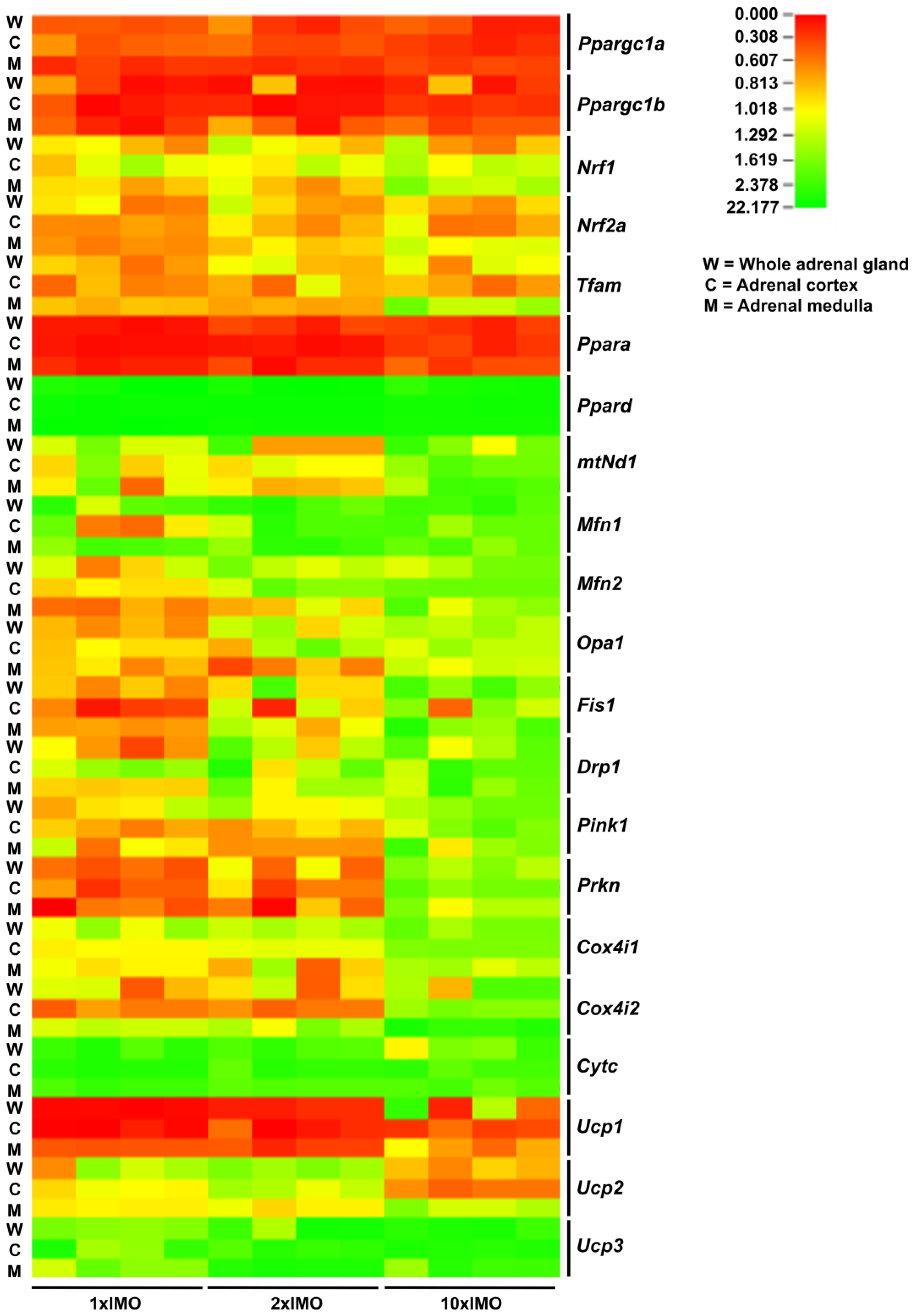
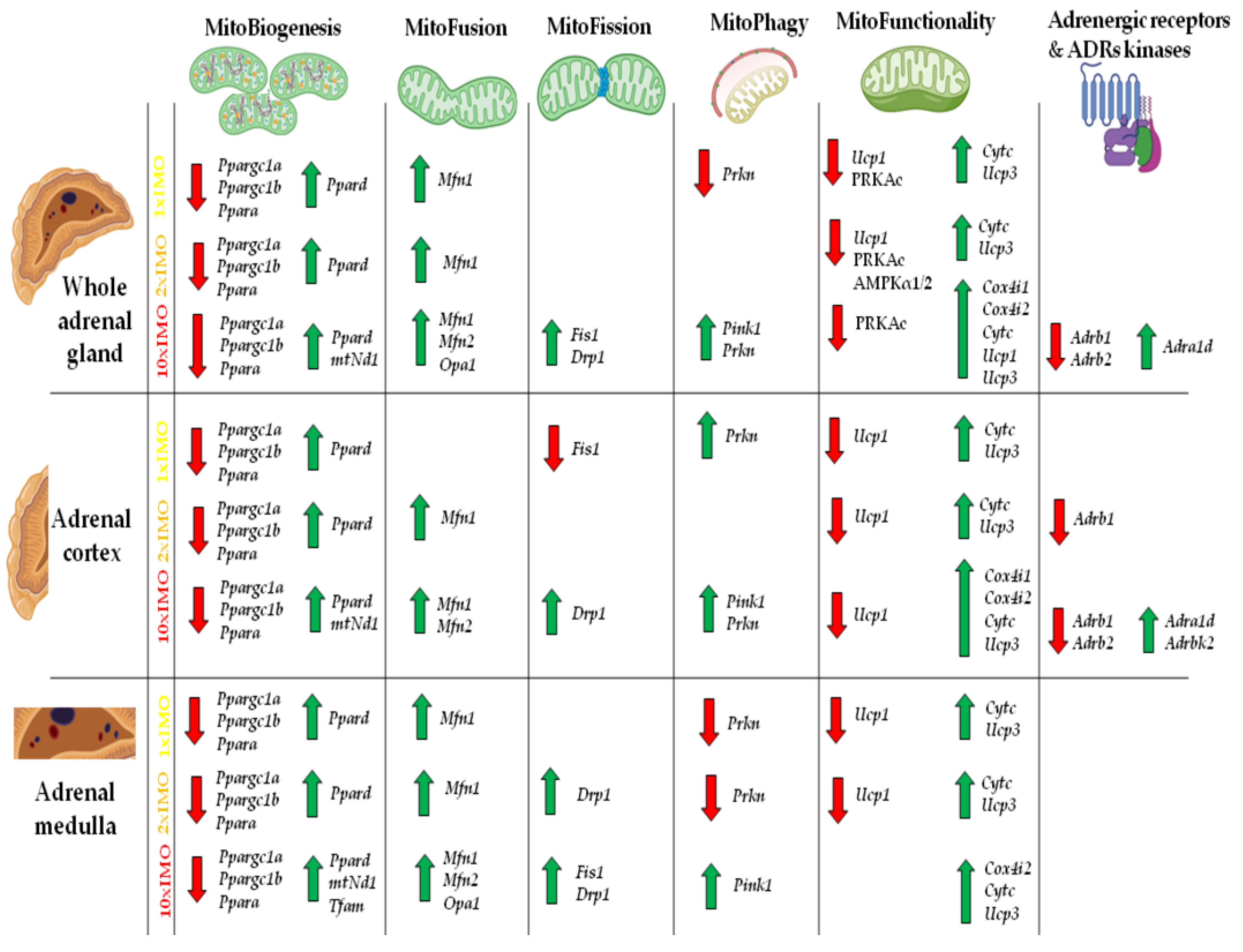
Disclaimer/Publisher’s Note: The statements, opinions and data contained in all publications are solely those of the individual author(s) and contributor(s) and not of MDPI and/or the editor(s). MDPI and/or the editor(s) disclaim responsibility for any injury to people or property resulting from any ideas, methods, instructions or products referred to in the content. |
© 2023 by the authors. Licensee MDPI, Basel, Switzerland. This article is an open access article distributed under the terms and conditions of the Creative Commons Attribution (CC BY) license (https://creativecommons.org/licenses/by/4.0/).
Share and Cite
Keselj, I.M.; Bozic, F.N.; Vucinic, M.M.; Lalosevic, D.; Kostic, T.S.; Andric, S.A. Transcriptional Profiles of Mitochondrial Dynamics Markers Are Disturbed in Adrenal Glands of Stressed Adult Male Rats. Life 2023, 13, 1457. https://doi.org/10.3390/life13071457
Keselj IM, Bozic FN, Vucinic MM, Lalosevic D, Kostic TS, Andric SA. Transcriptional Profiles of Mitochondrial Dynamics Markers Are Disturbed in Adrenal Glands of Stressed Adult Male Rats. Life. 2023; 13(7):1457. https://doi.org/10.3390/life13071457
Chicago/Turabian StyleKeselj, Isidora M., Filip N. Bozic, Miodrag M. Vucinic, Dusan Lalosevic, Tatjana S. Kostic, and Silvana A. Andric. 2023. "Transcriptional Profiles of Mitochondrial Dynamics Markers Are Disturbed in Adrenal Glands of Stressed Adult Male Rats" Life 13, no. 7: 1457. https://doi.org/10.3390/life13071457
APA StyleKeselj, I. M., Bozic, F. N., Vucinic, M. M., Lalosevic, D., Kostic, T. S., & Andric, S. A. (2023). Transcriptional Profiles of Mitochondrial Dynamics Markers Are Disturbed in Adrenal Glands of Stressed Adult Male Rats. Life, 13(7), 1457. https://doi.org/10.3390/life13071457






